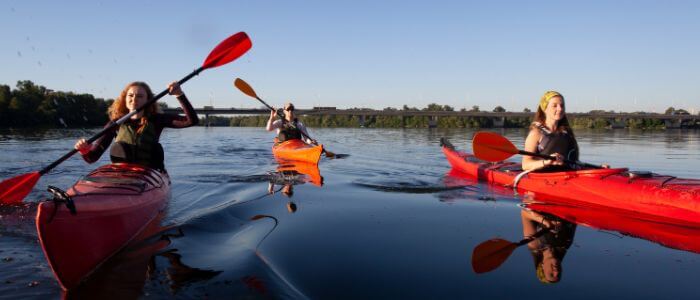
California welcomes its residents and tourists to enjoy kayaking on its waters, whether its pacific coastline or the lakes and rivers surrounded by beautiful landscapes. But, you have to know some rules and regulations for kayaking in California. And you can get yourself into trouble if you don’t follow the California kayaking laws. So make sure that you are aware of these rules and regulations before going on your next kayaking trip in California.
Your safety matters a lot to the state, and for this reason, California state has derived some kayaking laws. The primary goal of these laws is that; you can have fun safely.
So, here is detailed information on California kayaking laws.

If you have a paddle-propelled kayak, you don’t need any registration. No certificate or permission is required to operate a human-powered boat in the state.
But if your kayak or canoe is attached to the motor, you have to register your boat first in the department of motor vehicles (DMV) before entering the water. After the registration, your boat will be allotted a number, a certificate, and the registration stickers that must be adhered to on your boat.
So, there is no need for registration for manual kayaks, and registration is mandatory for the motorized kayak. This is an important aspect to consider when you want to buy a kayak.
You should check whether your kayak needs registration or not before buying one. If it does, then make sure that the seller provides all the necessary documents with the boat.
To operate a motorized canoe or kayak in California, you must have a boater card. As of 2022, the boating card is mandatory for people 45 years and under. The state gradually issued this card to different age groups. After some years, it will be mandatory to operate the boat for people of all ages.
In 2023, it will be mandatory for people 50 or under. From 2024, the age will be 60, and in 2025 all age of boaters will have to complete the course and carry the boater card.
This is an important step by the California government in providing safety to the boating community. The state is also considering making it mandatory for all kayaks, canoes, and other motorized boats to have a registration number on their vessels. This will help authorities track down missing boats quickly and easily.
It is illegal in California to operate a motor boat or kayak under the influence of drugs and alcohol or have a blood alcohol content of 0.08%. The BUI (boating under the influence) is prosecuted under the California harbors and navigation code 665.
But if it is between 0.08% and 0.05% and officers find you intoxicated, you will be arrested and will get BUI. But it does not apply to the kayaks or canoes that are self or water-propelled.
So, never try to operate a boat while under the influence of alcohol or drugs. And if you are planning to go kayaking with your friends, make sure they don’t have any kind of BUI. Otherwise, you will have to face some serious consequences. The BUI is one of the most serious crimes you can commit while kayaking.
According to California kayaking laws, the penalties of BUI (boating under the influence) and DUI (driving under the influence) are almost the same in the state. If a person is arrested for operating a motor boat under the influence will be requested for a chemical test to determine blood-alcohol content. If the 0.08% alcohol is found by his or her weight, it can be set to 3 to 5 years of probation, fines, and in some situations, six months of jail.
California State has a zero-tolerance policy in BUI for teenagers. If a person under 21 years of operating a motor boat found even more than 0.01% of alcohol in his or her body weight, he or she can get penalties of fine or participation in an alcohol education or community service program.
Penalties for repeating BUI are stricter in the state.
The state is so much concerned about the safety essentials on the boat. The state has observed that most deaths and injuries during paddling sports and kayaking were due to the lack of knowledge about using lifesaving essentials. Here are the rules that the state has derived
So, always wear a PFD because it will not just protect you from fines but also from getting injured or dead. The best thing is that the PFDs are very comfortable and lightweight, so you won’t even feel them on your body. It only takes a few minutes to put on your PFD, so if you are going out on your boat or kayak, make sure you have one.
Non-powered kayaks require at least one light. To avoid a collision, this light is required only when the kayak is anchored or with less sunlight, especially during sunrise and sunset.
There must be red and green lights around the vessel to display the stern light for a long canoe or vessel less than 12 meters or 39 feet 4 inches. These lights must be on during the sunrise and sunset or during less visibility.
Navigation lights will help others see your kayak, which is very helpful for preventing crashes or collisions. Similarly, the navigation lights for your kayak will help you to see the other boats on the water, which is very important. Also, it helps you to avoid collisions.
There should be a sound device on the kayak or canoe to produce a loud sound in case of any emergency. For long vessels, the sound device could be a horn or whistle or any other powerful device that can make a sound audible for at least one-half mile. These sound devices are very useful to avoid collision or to hail for help during less visibility.
The best and simplest sound device is a whistle that should be attached to your PFD. The whistle should be attached in a place that is easily accessible to your mouth.
VDS devices are also essential in vessels and kayaks, leaving emergency signals and calling for help. The common VDS devices that could be used.
The use of VDS devices is important for the safety and security of boaters. It is also crucial that you know the laws regarding using and carrying these devices in your boat or vessel. You don’t want to get in trouble with the authorities because you didn’t follow the rules.
So these are California Kayaking Laws that you have to follow in order to enjoy your kayaking trip. If you plan a kayaking trip to California, make sure you know the laws and regulations. You have to know that kayaking is a fun sport, and you can get yourself into trouble if you don’t follow the rules. So make sure that you are aware of these rules and regulations before going on your next kayaking trip.

Hey there kayak lovers! I’m Jay Schwartz, the author here at Kayak Guidance! You know water sports – you know me! My life is all about it. Kayaking, Paddleboarding, Fishing, Snorkeling and so much more. I love to share my passion and knowledge with all of you.

Hey there kayak lovers! I’m Jay Schwartz, the author here at Kayak Guidance! You know water sports – you know me! My life is all about it. Kayaking, Paddleboarding, Fishing, Snorkeling and so much more. I love to share my passion and knowledge with all of you.

Welcome to KayakGuidance.com! If you’re looking to have some fun outdoor water adventures, then you have come to the right place. We help our readers find the best kayaks and water related equipment to help you have the best time of your life whenever you are engaging in water activities.
This site is a participant in the Amazon services LLC associates program, an affiliate advertising program designed to provide a means for sites to earn advertising fees by advertising and linking to Amazon.com.